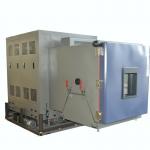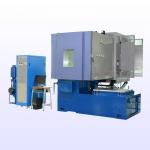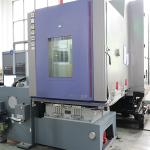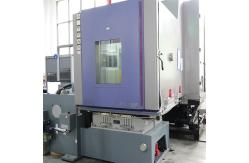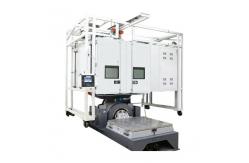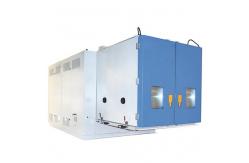In the automotive industry, ensuring the reliability and durability
of vehicle components is of utmost importance. The Automotive
Vibration Chamber with Temperature and Humidity Test, which
complies with IEC 60068, is a state-of-the-art solution that
enables comprehensive testing of automotive parts under various
environmental and mechanical stress conditions. This advanced testing chamber is designed to simulate the
vibrations, temperature changes, and humidity levels that vehicle
components may encounter during their operational lifespan. It
serves automotive manufacturers, suppliers, and research
institutions. The primary purpose is to evaluate the performance
and integrity of components such as electronic control units,
sensors, connectors, and mechanical parts. By subjecting these
components to a wide range of environmental and vibration stimuli,
manufacturers can identify potential weaknesses, optimize designs,
and ensure compliance with industry standards, ultimately enhancing
the safety and quality of vehicles. - Robust and Insulated Chamber Structure
- The vibration chamber is constructed with a heavy-duty steel frame
and insulated panels. The steel frame provides excellent rigidity
and stability to withstand the intense vibrations generated during
testing. The insulated panels ensure precise control of temperature
and humidity levels within the chamber. The insulation material has
a low thermal conductivity, minimizing heat transfer from the
external environment and allowing for accurate temperature
regulation. The chamber is also sealed to prevent any leakage of
conditioned air, maintaining a consistent and stable testing
environment.
- High-Precision Vibration System
- Equipped with a state-of-the-art vibration system, the chamber can
generate a wide range of vibration frequencies and amplitudes. It
can simulate vibrations from low-frequency road bumps to
high-frequency engine vibrations. The vibration table is made of
high-strength alloy steel and is precisely balanced to ensure
uniform and accurate vibration transmission. The system is
controlled by a computerized controller that allows for precise
programming of vibration profiles. It can generate random
vibrations, sine waves, and shock pulses, replicating real-world
driving conditions. The vibration amplitude can be adjusted from a
few micrometers to several centimeters, and the frequency range can
span from 5 Hz to 2000 Hz.
- Advanced Temperature and Humidity Control
- The chamber features a sophisticated temperature and humidity
control system. It is capable of maintaining a wide temperature
range, from -40°C to +150°C, with an accuracy of ±1°C. The humidity
control range is from 10% to 95% relative humidity, with an
accuracy of ±3% RH. The system uses high-quality refrigeration
compressors, heaters, and humidifiers/dehumidifiers to achieve and
maintain the desired environmental conditions. The temperature and
humidity sensors are strategically placed within the chamber to
ensure accurate monitoring and feedback control. The control system
also has a built-in self-calibration function to ensure long-term
accuracy.
- Compliance with IEC 60068 Standards
- The chamber is specifically designed and calibrated to meet the
requirements of IEC 60068, a widely recognized international
standard for environmental testing. It can perform various test
procedures specified in the standard, such as temperature cycling,
humidity testing, combined temperature and humidity testing, and
vibration testing. The test parameters, such as temperature limits,
humidity levels, vibration frequencies, and test durations, can be
easily adjusted to match the specific requirements of different
automotive components and testing scenarios. This compliance
ensures that the test results are valid and comparable,
facilitating product certification and market acceptance.
- User-Friendly Control Interface and Data Logging
- The chamber is equipped with a user-friendly control interface that
allows operators to easily set up and monitor tests. The interface
has a touch-screen display that provides real-time information
about the chamber's temperature, humidity, vibration status, and
test progress. Operators can input test parameters, select test
profiles, and start/stop tests with a few simple taps. The chamber
also has a built-in data logging system that records all relevant
test data, including temperature, humidity, vibration levels, and
test times. The logged data can be exported in various formats,
such as Excel or PDF, for further analysis and reporting.
- Maximum Vibration Displacement
- The chamber can achieve a maximum vibration displacement of ±50 mm.
This large displacement range allows for the simulation of severe
vibration conditions, such as those encountered during off-road
driving or high-speed impacts. For example, when testing the
suspension components of a vehicle, a large vibration displacement
can help evaluate their durability and performance under extreme
conditions.
- Vibration Frequency Range
- As mentioned, the frequency range of the vibration system is from 5
Hz to 2000 Hz. This wide range covers the frequencies of various
vehicle vibrations, from the low-frequency vibrations caused by the
rotation of the wheels and the engine's idle speed to the
high-frequency vibrations of the transmission and other mechanical
components. Testing across this frequency range ensures that all
potential resonance frequencies of the components are identified
and evaluated.
- Temperature Control Range
- The chamber can maintain a temperature control range from -40°C to
+150°C. This broad range is essential for simulating the extreme
temperature conditions that vehicles may experience, from the
coldest winter nights to the hottest summer days. For example,
electronic components in a vehicle's engine compartment may need to
function properly at high temperatures, while exterior components
like door handles and mirrors must withstand freezing temperatures.
- Humidity Control Range
- The humidity control range of 10% to 95% relative humidity allows
for the testing of components in different moisture environments.
High humidity levels can affect the performance of electrical
connectors and cause corrosion, while low humidity can lead to
static electricity issues. Testing components at various humidity
levels helps ensure their reliability in different climatic regions
and operating conditions.
- Maximum Payload Capacity
- The chamber has a maximum payload capacity of up to 1000 kg. This
capacity is sufficient for testing a wide range of automotive
components, from small electronic modules to larger mechanical
assemblies. It allows manufacturers to test multiple components or
a complete vehicle subsystem at once, increasing testing
efficiency.
- Accurate Evaluation of Component Durability
- The primary function of the chamber is to provide a precise and
reliable assessment of how automotive components will fare when
subjected to a combination of vibrations, temperature changes, and
humidity levels. By carefully controlling these parameters and
following the IEC 60068 standards, it determines the extent of
damage or degradation t
|
